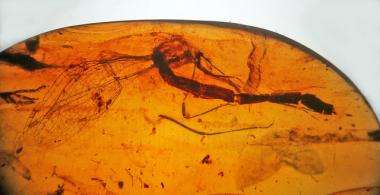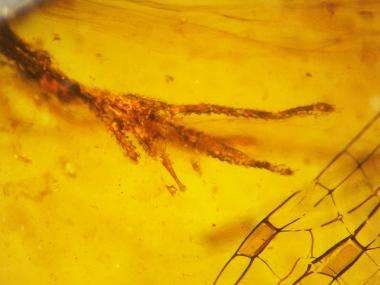Halloween horror story -- tale of the headless dragonfly

In a short, violent battle that could have happened somewhere this afternoon, the lizard made a fast lunge at the dragonfly, bit its head off and turned to run away. Lunch was served.
But the battle didn't happen today, it happened about 100 million years ago, probably with dinosaurs strolling nearby. And the lizard didn't get away, it was trapped in the same oozing, sticky tree sap that also entombed the now-headless dragonfly for perpetuity.
This ancient struggle, preserved in the miracle of amber, was just described by researchers from Oregon State University in Paleodiversity, a professional journal. It announced the discovery of a new sub-family of dragonflies, called "Paleodisparoneurinae," in the oldest specimen of this insect ever found in amber.
More importantly, the study and others like it continue to reveal the similarities of behaviors and ecosystems separated by many millions of years, said George Poinar, a professor emeritus at Oregon State University. Poinar is one of the world's leading experts on life forms found preserved in this semi-precious stone that acts as a natural embalming agent.
"Dragonflies are still eaten by small lizards every day, it's a routine predator/prey interaction," Poinar said. "This shows once again how behaviors of various life forms are retained over vast amounts of time, and continues to give us insights into the ecology of ancient ecosystems."
Dragonflies are one of the world's more colorful, interesting and successful insects, Poinar said, having managed to survive for a very long time. This is the oldest fossil ever found in amber, but other stone fossil specimens of dragonflies date back as much as 300 million years, including some that were huge, with wingspans up to three feet.

Amber is a semi-precious stone that originates as the sap from certain trees. Later fossilized through millions of years of pressure, it's unique for the ability to capture and preserve in near-lifelike form small plant, animal or insect specimens that provide data on ancient ecosystems.
"Dragonflies are now, and probably were then, very quick, evasive, and greedy predators," Poinar said. "They feed on other larvae and insects, mosquitoes, gnats, lots of things. Some are quite beautiful, very popular with insect collectors. And some modern populations like to migrate regionally, going south to mate."
But as the new amber specimen shows, dragonflies are now and for a long time have also been prey, particularly of small lizards. Young and hatchling dinosaurs also probably dined on them, Poinar said.
The quick and merciless battle preserved in this stone took place in the Early Cretaceous somewhere between 97 million to 110 million years ago in the jungles of the Hukawng Valley of Burma, now known as Myanmar. The dragonfly – with one notably missing part – is preserved almost perfectly. Only the foot and tail of a small lizard remains in the stone, presumably as the animal was trying to flee.
"It's unfortunate we don't have the entire specimen of the lizard, because it probably had the dragonfly's head in its mouth," Poinar said. "Both died when they were trapped in the tree sap in the middle of this duel."
Like a never-ending feud, these battles are still going on today. Scientists have documented in some sites near waterfalls in Costa Rica that there are many dragonflies of a certain species. But if lizards are present, there are no dragonflies – it appears they all get eaten.
Sometimes things change. Sometimes they don't.
Provided by Oregon State University


















